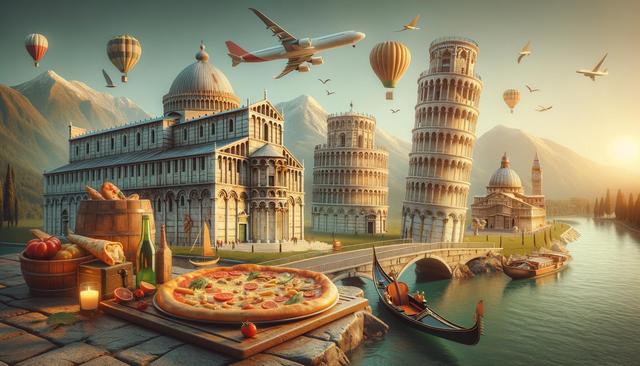Your Complete Italy Vacation Guide
An Italy vacation guide is your key to discovering the best attractions, dining, and accommodations. Whether you’re exploring Rome’s ancient history or Venice’s canals, this guide will help you plan the perfect Italian getaway.

Planning Your Trip: When to Go and What to Pack
Italy offers something for every type of traveler year-round, but the best time to visit largely depends on your interests. Spring (April to June) and fall (September to October) are ideal for avoiding large crowds and experiencing mild weather. Summer can be hot, especially in cities like Rome and Florence, but it is also when festivals are in full swing. Winter, particularly around the holidays, transforms cities into charming, less crowded destinations with festive lights and seasonal markets.
When packing for Italy, consider the nature of your trip. For city explorations, comfortable walking shoes are essential. If you’re heading to the coast or countryside, lightweight clothing, sun protection, and swimwear are must-haves. For visits to churches or religious sites, modest attire is recommended. Here are a few essentials to keep in mind:
- Weather-appropriate clothing with layers
- Adapters for European outlets
- A translation app or phrasebook
- A reusable water bottle – Italy’s public fountains offer clean drinking water
Planning ahead also means booking accommodations and major attractions in advance. Sites like the Colosseum or the Uffizi Gallery often require timed entry, especially during peak seasons.
Top Cities to Explore in Italy
Italy is home to some of Europe’s most iconic cities, each offering a unique blend of culture, architecture, and history. Rome, the capital, is a must-visit for its ancient ruins, Vatican City, and vibrant street life. Florence, known as the cradle of the Renaissance, offers world-class art and stunning cathedral architecture. Venice, with its winding canals and romantic gondola rides, is unlike any other city in the world.
Each city has its own character and highlights:
- Rome: The Colosseum, Trevi Fountain, and Roman Forum
- Florence: The Duomo, Uffizi Gallery, and Ponte Vecchio
- Venice: St. Mark’s Basilica, Doge’s Palace, and Grand Canal
For a deeper experience, consider lesser-known cities like Bologna, with its culinary scene, or Turin, known for its elegant boulevards and Baroque architecture. These cities offer a more relaxed pace and fewer crowds while still delivering rich cultural experiences.
Discovering Italy’s Diverse Regions
Beyond the major cities, Italy’s regions offer a wide range of experiences. From the rolling hills of Tuscany to the dramatic cliffs of the Amalfi Coast, each area has its own charm. Northern Italy is known for its alpine scenery and lakes, such as Lake Como and Lake Garda, while southern Italy boasts sun-drenched beaches and ancient ruins.
Here are a few standout regions to consider:
- Tuscany: Famous for vineyards, medieval towns, and scenic drives
- Amalfi Coast: Picturesque villages like Positano and Ravello
- Sicily: A mix of Greek temples, volcanoes, and coastal beauty
- Umbria: Often called the ‘green heart of Italy,’ known for olive groves and hill towns
Exploring these areas by car can provide the most flexibility, especially when visiting smaller towns and rural landscapes. Alternatively, Italy’s train network connects many regional hubs, making it easy to get around without driving.
Italian Cuisine: A Culinary Journey
No Italy vacation guide is complete without diving into the country’s renowned cuisine. Italian food varies significantly by region, offering a wide spectrum of flavors and ingredients. While pasta and pizza are global favorites, local specialties give each region its own culinary identity. In Emilia-Romagna, try handmade tortellini; in Naples, the birthplace of pizza, enjoy an authentic Margherita straight from a wood-fired oven.
Don’t miss these culinary experiences:
- Gelato: A must-have dessert, available in countless flavors
- Espresso: Enjoyed standing at a local café
- Truffle dishes: Especially in regions like Piedmont and Umbria
- Seafood: Fresh and flavorful along the coastal regions
Dining in Italy is not just about the food—it’s a cultural experience. Meals are often leisurely affairs, especially dinner, which typically starts around 8 p.m. Reservations are recommended for popular restaurants, and tipping is modest, as service is usually included in the bill.
Accommodation and Travel Tips
Italy offers a wide range of accommodations to suit every budget and travel style. From boutique hotels in historic buildings to countryside villas and budget-friendly hostels, the options are plentiful. Agriturismos—farm stays typically found in rural areas—offer a unique way to experience local hospitality and cuisine.
When choosing where to stay, consider proximity to transportation, especially if you plan to use trains or buses. Staying near a city center often allows you to explore on foot and reduces reliance on taxis or public transport.
Here are a few travel tips to make your experience smoother:
- Validate your train ticket before boarding regional trains
- Carry some cash, especially in small towns where card payments may not be accepted
- Be aware of pickpockets in crowded tourist areas
- Learn a few basic Italian phrases—it’s appreciated by locals
Italy’s public transport is generally reliable, and high-speed trains connect major cities efficiently. For more freedom, especially in rural areas, renting a car can be beneficial. Just be prepared for narrow roads and limited parking in some towns.
Final Thoughts: Crafting Your Ideal Italian Getaway
Italy’s rich tapestry of art, history, landscapes, and cuisine makes it a rewarding destination for travelers of all kinds. Whether you’re soaking up the Renaissance charm of Florence, cruising the canals of Venice, or savoring local wines in Tuscany, there’s no shortage of memorable experiences. With careful planning and a sense of adventure, your Italian vacation can be as relaxing or adventurous as you wish. Use this guide to build an itinerary that reflects your interests, and you’ll return home with a deeper appreciation for all that Italy has to offer.